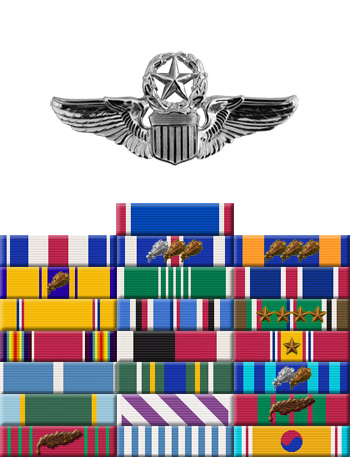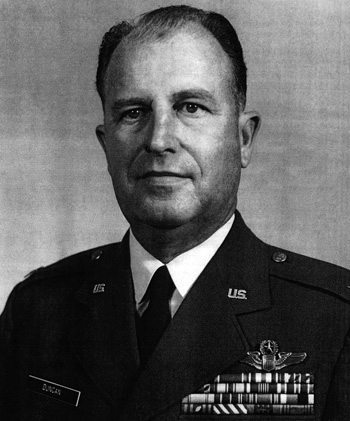
|
Glenn E. Duncan |
 |
|||
| Rank, Service | ||||
Colonel O-6, U.S. Air Force |
||||
| Veteran of: | ||||
|
||||
| Tribute: | ||||
Glenn Duncan was born on May 19, 1918, in Bering, Texas. He enlisted in the Aviation Cadet Program of the U.S. Army Air Corps on February 9, 1940, and was commissioned a 2d Lt and awarded his pilot wings at Kelly Field, Texas, on October 5, 1940. Duncan served as an instructor pilot for a year and then served in Panama from December 1941 to January 1943, before completing P-47 Thunderbolt training and being assigned first to the 361st Fighter Group, and then to the 353rd Fighter Group in England in March 1943. Col Duncan was credited with destroying 19.5 enemy aircraft in aerial combat plus 1 probable and 7 damaged, as well as 9 on the ground while strafing enemy airfields, before ditching his aircraft in Germany in July 1944. He escaped on foot to Holland and joined the Dutch underground until he was liberated in April 1945. Duncan then rejoined the 353rd Fighter Group as its commanding officer, serving until October 1945, when he returned to the U.S. He then returned to Germany and served on occupation duty from January to August 1946, before serving as an instructor with the Air National Guard until June 1949, when he became a White House Liaison Officer. Col Duncan served at the White House and with Headquarters U.S. Air Force in the Pentagon until May 1953, when he was transferred to Japan to serve as Deputy Commander of the 39th Air Division from August 1953 to July 1956. His next assignment was as Commander of the 1st Fighter Wing at Selfridge AFB, Michigan, from September 1956 to August 1959, before attending the Industrial College of the Armed Forces from August 1959 to July 1960. Col Duncan next served on the staff of Headquarters Air Defense Command at Ent AFB, Colorado, from July 1960 to September 1965, followed by service as Deputy Commander of the 314th Air Division at Osan AB, Korea, from September 1965 to June 1966. He served as Base Commander of Stewart AFB, New York, from August 1966 to August 1969, and then as Special Assistant to the Vice Commander of 1st Air Force at Stewart AFB, from August 1969 until his retirement from the Air Force on February 1, 1970. Glenn Duncan died on July 14, 1998, and was buried at Arlington National Cemetery. |
||||
|
||||

